Optimising functional ingredients for enhanced nutritional values
Now that functional ingredients have established themselves as a dynamic market segment, the optimization of particle design has become increasingly important. The growing complexity of functional products is putting greater demands on established production processes. Fluidized bed and spouted bed processes offer manufacturers almost unlimited possibilities in terms of optimised particle design and the functionalisation of ingredients.
- originally published in the trade magazine ‘Nutraceuticals Now’, issue 09/2016, Johnson-Johnsen Publishing
Now that functional ingredients have established themselves as a dynamic market segment, the optimization of particle design has become increasingly important. The growing complexity of functional products is putting greater demands on established production processes. For example, manufacturers are faced with the challenge of ensuring ingredient stability throughout the entire shelf-life of the product. Furthermore, the taste of many ingredients needs to be enhanced, their release profiles must be carefully controlled and they must dissolve easily in water. Moreover, active micro-components such as vitamins, minerals, flavours or probiotics, cannot be incorporated into foodstuffs in their natural state; they have to be coated or encapsulated.
The industrial-scale production of innovative food ingredients requires state-of-the-art technologies. For successful formulation, fluidized bed technologies can play a key role in adjusting product attributes to achieve optimal results.
Efficient ways of processing
Both fluidized and spouted bed technologies are based on the principle of fluidizing particles using upward-flowing process gas. These systems consist mainly of the inlet gas chamber, the process chamber, the spray system and the filter system. Also used to bulk dry a variety of materials, both technologies make the process more efficient by suspending the material to be dried and exposing its entire surface to the air.
A distribution plate ensures that the gas current has defined flow characteristics, which assists with the mixing process and creates the fluid bed. Nevertheless, fluidized and spouted beds have different properties in terms of fluid mechanics and process dynamics. As well as flow profiles that influence the temperature and material transfer rates, the main difference is the design of the process chambers.
More than just hot air
To preserve the functional and nutritional properties of the ingredients, short retention times with higher heat and matererial transfer rates lead to the gentle handling of temperature-sensitive materials. In food applications, products are typically subjected to a moderate heat of 30–50 °C, meaning that temperature-sensitive ingredients such as enzymes, proteins, flavourings, vitamins and micro-organisms can also be treated. Plus, beyond the thermal treatment of solid materials, fluidized and spouted bed technologies can be used to produce granules from powders or liquids and/or to coat and encapsulate particles as well.
Functional surfaces
When it comes to valuable active substances, film or hot-melt coatings are well proven solutions. Long-term stability, resistance to oxidation and targeted release are among the most important requirements. For manufacturers of nutritional supplements, protecting their valuable active ingredients is vitally important. A functional film coating not only provides a smooth layer that makes capsules easy to swallow, it also offers a protective barrier against oxygen, light and moisture.
Coatings can also improve the release characteristics of active ingredients. A functional surface layer can be created that, depending on the pH, either partially or completely dissolves, offering slow, targeted or controlled release mechanisms for specific ingredients. When used in food production, for instance, the release of citric or lactic acid during the maturation of sausages can be controlled by coatings. Moreover, coatings can mask the sometimes undesirable tastes associated with certain ingredients. Vitamins and mineral mixtures often have a metallic or astringent taste if mineral salts are used.
Microcapsules: depot effect
Probiotic foods represent another application opportunity for the sustained release of active ingredients. Only if the probiotic microorganisms reach the small intestine alive will they have a chance to multiply and positively affect the intestinal flora. This means that they have to pass safely through the stomach. And probiotics that are destined to reach the colon also have to be protected against bile acids and digestive enzymes in the small intestine. To successfully transport probiotic cultures into the intestinal tract, they are added to foods in the form of microcapsules that open or dissolve in a pH-dependent manner. For other nutraceutical applications, functional ingredients can be microencapsulated into a free-flowing powder or granulate that’s coated with a millimetre- or even micrometre-thick layer of polymers, starch derivatives, lecithin or gelatine, for example, making them resistant to external influences.
Spray granulation for granules from liquids
Spray granulation enables granule formation and release control to be done in a single step. During spray granulation, liquids are sprayed onto fluidized particles, which dry on the granule surface and thereby create a layered accumulation of particles. With the help of spray granulation, it is possible to dry liquid food additives — such as stabilisers, flavours or sweeteners — while precisely adjusting their particle size, residual moisture levels and solids content, resulting in round pellets with excellent physical properties.
The outcome is a free-flowing homogenous granulate that is virtually dust-free and very easy to dose. Moreover, the hardness and abrasion resistance of the granules is significantly higher than conventionally dried substances. Spray granulation is particularly suitable for dry food additives and encapsulated ingredients.
Readily soluble agglomerates
Instant products, for example, benefit from the use of high viscosity spray solutions to achieve larger agglomerate structures, which leads to better dispersibility. Like spray granulation, agglomeration makes the product easier to handle. Moreover, agglomeration prevents the individual constituents from separating when processed. Using fluidized bed technology, poorly soluble powders can be transformed into agglomerates that dissolve much more readily in water – instant cocoa powder and cappuccino drinks, for example.
During the agglomeration process, fine powder particles are stuck together with a liquid to form grain-on-grain structures. Wetting the surface of these particles and subsequent drying causes the powder particles to adhere to each other and form free-flowing porous agglomerates. As such, it is possible to make dust-reduced, easy to portion powders for drink dispensers and readily dispersible dried powdered milk.
Solutions for various customer requirements
The selection and combination of the right process parameters depends on the required product properties: How fast, if at all, should effervescent tablets dissolve? When should the vitamin or any other active ingredient — alone or in combination — be released? What role does bulk density play in terms of application, handling, storage and packaging, and how stable do the particles need to be?
Glatt Ingenieurtechnik, Germany, one of the leading suppliers of integrated plant solutions and an engineering service provider, knows how to tackle these issues. The company plans, develops and distributes fluidized bed and spouted bed systems for the food, feed and chemical industries. Glatt’s technologies enables manufacturers to optimise the properties of a wide range of products: from readily soluble drink powders comprising semi-hydrophobic components to dust-free agglomerated instant ingredients for tableting.
All-round service
Based on its comprehensive technology expertise, Glatt is able to offer solutions for demanding or complex applications that require precisely defined shape or solubility characteristics, homogenous particle sizes or the functional protection of active ingredients. Volker Budzinski, Sales Manager Process Technology Food, Feed & Fine Chemicals at Glatt Ingenieurtechnik, comments: “We don’t offer standardized, off-the-shelf production equipment. Our clients approach us with many different questions and requirements. Together, we develop the most suitable technological strategy. Primarily, we are solution providers. We develop and optimise processes for various applications, and also design the appropriate individual plant or even entire production lines that are ready to use. Whatever the project, we accompany our clients from initial start-up to conclusion.”
Taking an individual approach to each project, Glatt designs, develops and delivers plants that are customized to meet specific customer requirements. Process technologies are initially assessed in small-scale laboratory units (1–2 kg). Then, based on demand and the formulation, the company determines the optimal operational parameters in pilot studies, facilitating reliable scale-up. Glatt offers laboratory and pilot plants for early stage trials and testing, which are available both at the company’s technology centre in Weimar, Germany, as well as for use in the client’s own laboratories. And, based on its extensive consulting experience – from planning and construction to the implementation of tailor-made production plants — Glatt also offers comprehensive engineering services as well as entire turnkey solutions. With the introduction of the new Advanced Pulse Powder Technology Glatt Ingenieurtechnik has extended its technology expertise. With high-temperature processes, Glatt is able to produce particularly homogenous powder materials for high performance applications.
Conclusion
For the optimization of functional ingredients, fluidized bed and spouted bed technologies are a proven, highly adaptable and established technology. Furthermore, several processes for the specific enhancement of product properties can be combined in a single step. Of paramount importance is the experimental development of the process parameters required to get flawless high-quality products ready for market. Production parameters should be tested in laboratory and pilot-scale plant before being transferred to a batch-based or countinous production process.
How to enhance product properties
Fluid bed technology help to optimise functional ingredients:
- Instantization of powders with optimal instant behaviour
- Adjustable particle size, dust-free
- Enhanced flow properties, good dosing
- Prevents segregation of powder mixtures
- Easier tableting
- Low bulk density
- Dust-free round pellets with homogenous structure
- Good solubility and dispersibility
- High hardness and resistance to abrasion
- Narrow range of adjustable particle sizes
- High particle and bulk density
- Optimal protection for active substances against moisture, acids, oxidation, etc.
- Functionalizes particle surfaces, different layer thicknesses
- Targeted control of release behavior, such as odor or taste
- Increased storage compatibility and thermostability
- Compact granules with extended shelf-life
- Stabilization of volatile and valuable substances
- Various carrier systems for optimised functionality
- Targeted variation of base materials for adjusted particle structures
Further information on this topic and related topics can also be found in the following publications:
Published article: ‘Food, feed and pet nutrition:
a convergence of industries’ PDF, English
Published article: ‘How to Tame Recalcitrant Ingredients with Technological Processes’ PDF, English
Published article: ‘Spray agglomerating plant-based milk alternatives for optimised product properties’ PDF, English
Published article: ‘The gentle processing of highly volatile oils by fluid bed and spouted bed technology’ PDF, English
Published article: ‘Spray (micro)encapsulation of sensitive substances in matrix form – An overview of essential oil and vitamin case studies’ PDF, English

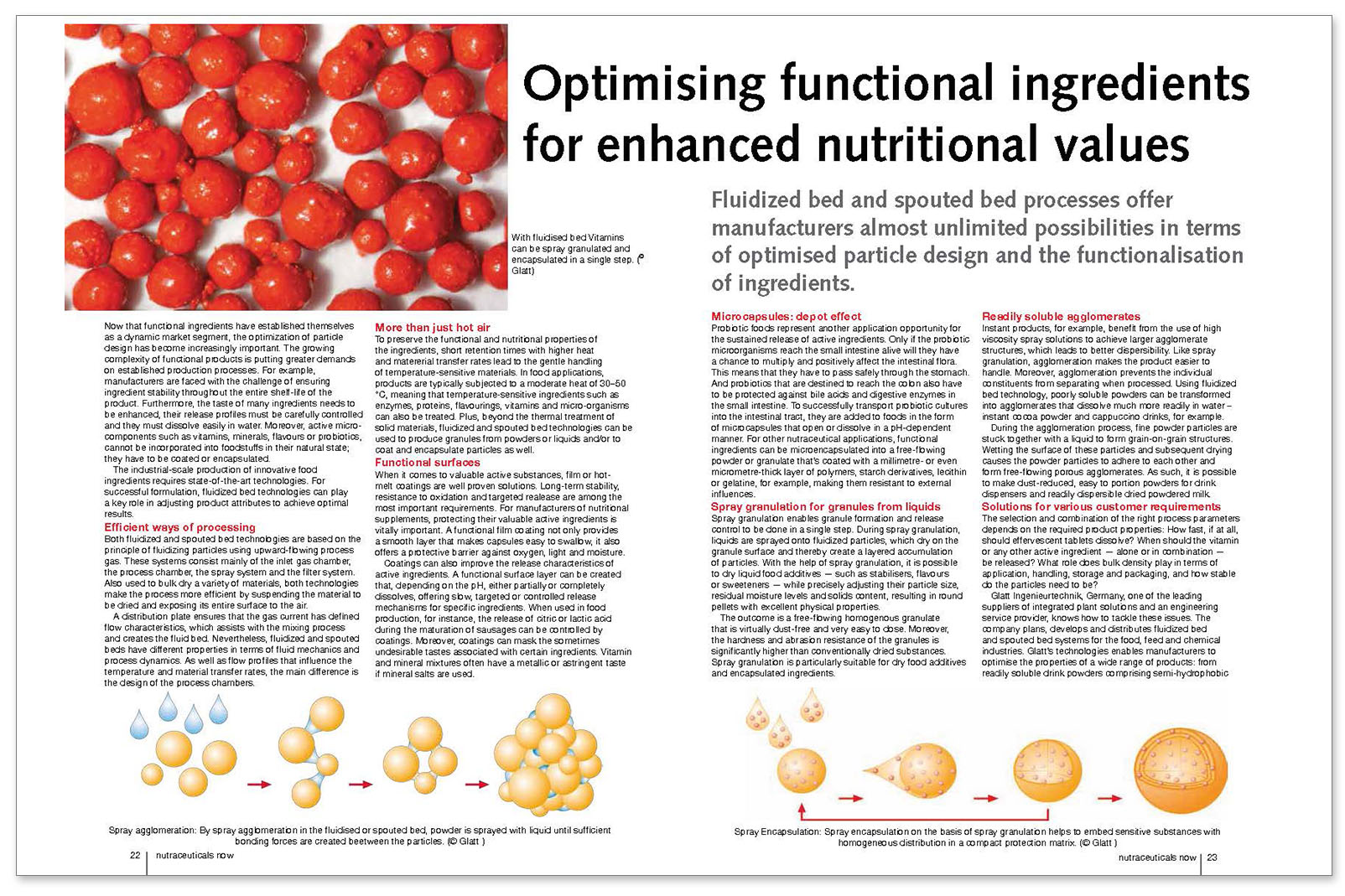
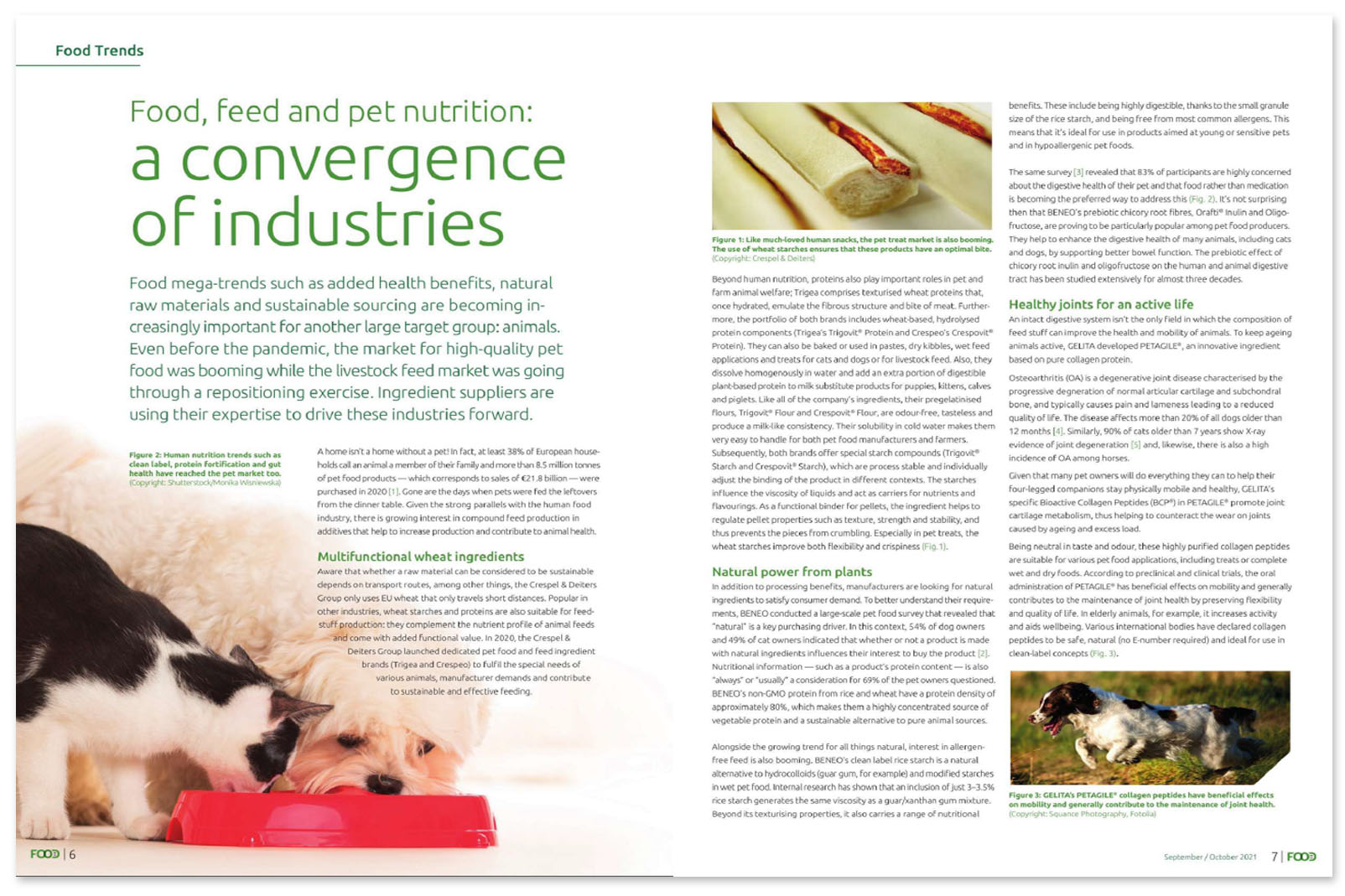
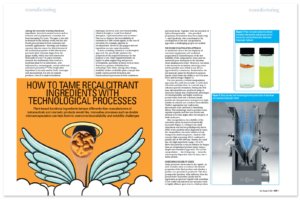
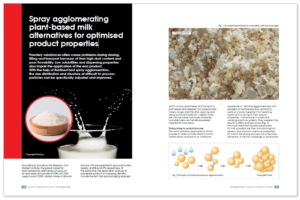
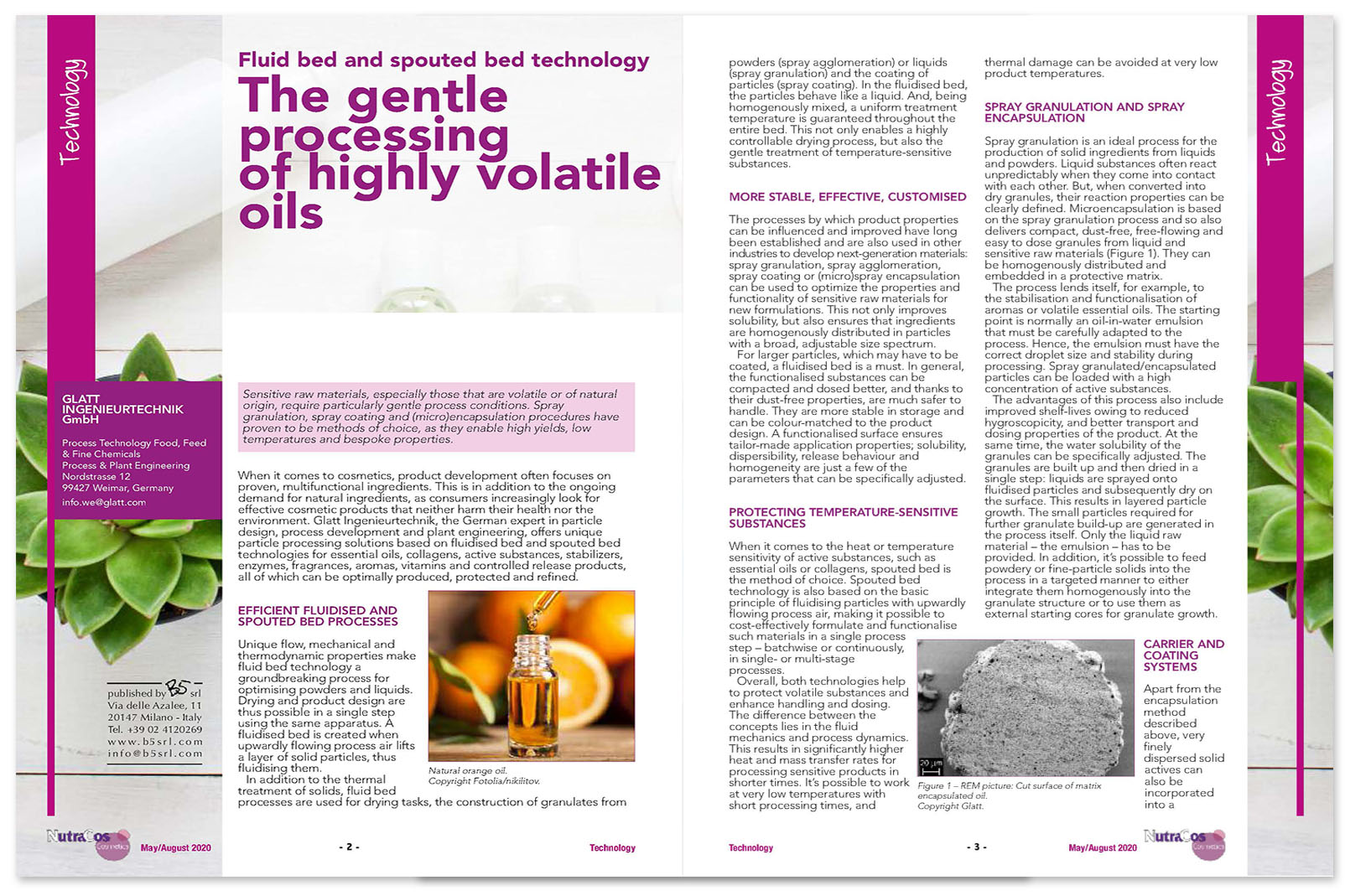
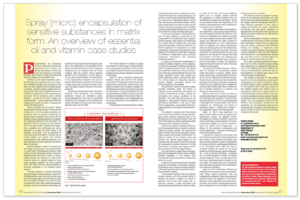
 Copyright: B5 S.r.l.
Copyright: B5 S.r.l. Copyright: Deutscher Fachverlag GmbH
Copyright: Deutscher Fachverlag GmbH